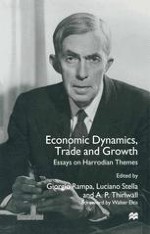1998 | OriginalPaper | Buchkapitel
The Harrod-Domar Equation from Quesnay to Marx to Harrod and Domar
verfasst von : Walter Eltis
Erschienen in: Economic Dynamics, Trade and Growth
Verlag: Palgrave Macmillan UK
Enthalten in: Professional Book Archive
Aktivieren Sie unsere intelligente Suche, um passende Fachinhalte oder Patente zu finden.
Wählen Sie Textabschnitte aus um mit Künstlicher Intelligenz passenden Patente zu finden. powered by
Markieren Sie Textabschnitte, um KI-gestützt weitere passende Inhalte zu finden. powered by
Roy Harrod’s pioneering establishment of growth theory in the mainstream of modern economic analysis was one of the most significant legacies of the Keynesian revolution. He was close to Keynes from 1922 onwards and he saw the galley proofs of The General Theory in 1935. He was at the same time working independently on The Trade Cycle which he published in 1936, a few months after Keynes’s book. This contained the nucleus of his new dynamic economics which emerged as ‘An Essay in Dynamic Theory’ in 1939. In the Preface to The Trade Cycle Harrod writes, ‘Mr. Keynes, in his recent volume, The General Theory of Unemployment, Interest and Prices1, has developed certain important ideas concerning the relations between the demand for capital goods, the propensity of the community to save, and its general level of activity and income. Full use is made of these.’ (Harrod, 1936, p. vii). In this 1936 Preface he also writes of his intention to establish dynamic analysis, ‘An attempt has been made in this essay to adopt a procedure in relation to the factor of growth similar to that of static analysis, to seek, namely, for the moving equilibrium of a steady rate of growth ... The consequences of this attempt are embodied in my theory of the “dynamic determinants”’. (ibid., pp. viii–ix).
